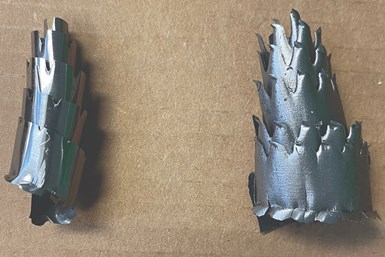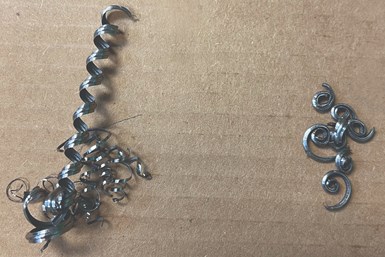Chips — Our Real Product
We don’t make parts. Parts are the result of the chips we make. And the chips can tell you all you need to know.

1215 Chip new tool (left) and end of tool life (right). Chips courtesy of Herker Industries Inc. Photo Credits: PMPA
Our shops sell precision machined parts — components that because of their geometry, features, dimensional control and properties enable today’s technologies to create our safe and modern quality of life. What many people overlook is that the parts we sell are the result of our material removal processes. The product of material removal is the removed material — the chips. The residue — that is, the material not removed — is the part. Precision machining is a process of precise creation and removal of material as chips in order to leave a remainder of the proper geometry, dimension and properties to deliver the critical functionality as designed by the customer’s engineers.
What do our customers want from us? Our customers come to us to fulfill their needs. What are their needs? Before you jump up with the reflexive answer, reflect for a minute. The customer is actually looking for functionality. Some means of performing some essential element of a process or deliverable in the product that they make and sell to their customers. The products that our company sells to customers are necessary for their product to function. Our parts are critical to the function of their product.
What Is Quality?
To the customer, it is the means necessary to provide the functionality in their application — conformance to design requirements, ease of installation and expected performance. To the world, quality is the absence of waste. This aligns with the customer’s desire as burrs, oversize or other nonconformances to specification are waste that can interfere with the functionality, ease of installation and expected performance.
What Is It That We Make?
Chips. We make chips. We DO NOT make parts! We make chips which, upon removal, result in a finished geometry which provides our customers with the functionality that they desire and creates the conforming geometry and features needed by their design which delivers the performance they expect from the functionality they desire. As machinists, we make chips.
What Is a Chip?
Remember, machining is a subtractive process. Chips are pieces of material removed from a workpiece by a cutting tool. It is our ability to make chips that creates the geometries that deliver the functionality and performance that the customer seeks. Additive makes a part. Our subtractive machining stock removal processes eliminate the unnecessary — the excess or waste material that is unneeded to form, fit and function. In other words, the chip.
The chips we create in our stock removal processes are the “waste” which is not needed in the raw material to deliver that functionality and performance. By taking stock removal, we eliminate waste, upgrading quality and enabling the raw material to reach its highest and best use.
We Make Chips!
Chips are our authentic work product. The part is what is left after we take all the stock removal. Our company sells parts that are the result of our chipmaking processes that provide customers with the functionality that they need. But. We. Make. CHIPS!
What is our process? Material Removal. How is it measured? It can be measured in either cubic inches of material removed per minute or cubic meters of material removed per minute. These are measures of the volume of chips we produce, even though we sell them by weight at the end of our work. Ironically, the majority of our shop’s processes value “add” is “stock removal” — material subtraction!

1020 DOM after tool change (left) and before tool change (right). Chips courtesy of Herker Industries Inc.
Types of Chips
There are many ways to characterize chips. Simplest for our purposes may be related to the process conditions — is the removal of the chip unconstrained, semi-constrained or constrained?
-
Unconstrained. Typically produced from tools taking stock removal on the OD like turning or form tools.
- Semi-constrained. Think of a tool cutting a groove which constrains the travel of the chip and the ability to get in fluid and remove the chip
- Constrained. A drill in a hole or deep hole produces chips which are constrained by the workpiece material surrounding the tool, preventing easy exit of the chip as well as obstructing application of cutting fluid.
Terms that Describe Chips
Chips can be described by adjectives such as long, short, coiled or snarled. Other terms can describe the chip by whether or not it is broken or well broken — as in resulfurized steels where the manganese sulfides create places for the chip to break. Materials without free machining additives may have chips that are semi-continuous or continuous.
Chip Character
Chip character is actually a term that describes less about the chip itself, but more about the way it behaves as it is being created and after it is separated.
-
Soft. Easily malleable, flows easily
- Semi-Soft. Malleable, flows.
- Semi-Hard. Definitely not soft, has ‘resistance’
- Hard. No malleability. Resists deformation or crushing
- Tough. Requires much force to deform or crush, but not springy
- Springy. Returns to initial shape after force is applied
There is no question that the economic model of our business is that we exchange parts that conform to a customer’s requirements for cash. That is the business process. But the value creation — the value add — of our performers is to improve the quality of a raw material by taking stock removal and removing chips, creating a residue that meets the customer’s requirements for conformance to design requirements, ease of installation and expected performance in their final deliverable.
We are precision machinists. Sales sells parts, we make chips that convert raw materials to their highest and best use by taking stock removal to achieve our customer’s desired functionality. That is the real secret of precision machining. We add value by subtraction — making chips!
Look at your chips. If you aren’t looking at your chips and listening to what they have to tell you, you are not paying attention to your process, which is making chips!
Read More Articles from PMPA:
About the Author
Miles Free III
Miles Free III is the PMPA Director of Industry Affairs with over 40 years of experience in the areas of manufacturing, quality, and steelmaking. He helps answer “How?, “With what?” and “Really?” Miles’ blog is at pmpaspeakingofprecision.com; email – mfree@pmpa.org; website – pmpa.org
Related Content
Onshoring Weather Report: Strong Tailwinds!
Onshoring, reshoring, nearshoring: these terms are showing up with increasing frequency in the news and online. But is there evidence that these are real?
Read MoreCraftsman Cribsheet No. 129: How to Beat the Heat
Shops tend to heat up in the summer. Here are some tips for staying cool in the warmer months.
Read MoreTurned and Polished Steel Barstock: How It Is Manufactured, How It Impacts Your Shop
Understanding the benefits provided by turned and polished steel barstock and its differences from cold-drawn steel barstock can help you and your team avoid unexpected performance issues.
Read MoreCold-Drawn Steel Barstock: How It Is Manufactured, Benefits to Your Shop
Understanding the benefits provided by cold-drawn steel barstock can help you optimize the work you quote by maximizing benefits to your manufacturing process and customer.
Read MoreRead Next
A Tooling Workshop Worth a Visit
Marubeni Citizen-Cincom’s tooling and accessory workshop offers a chance to learn more about ancillary devices that can boost machining efficiency and capability.
Read More5 Aspects of PMTS I Appreciate
The three-day edition of the 2025 Precision Machining Technology Show kicks off at the start of April. I’ll be there, and here are some reasons why.
Read MoreDo You Have Single Points of Failure?
Plans need to be in place before a catastrophic event occurs.
Read More








.jpg;maxWidth=300;quality=90)













